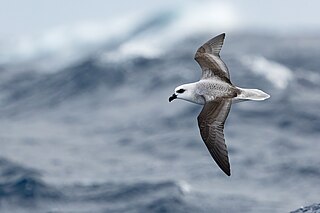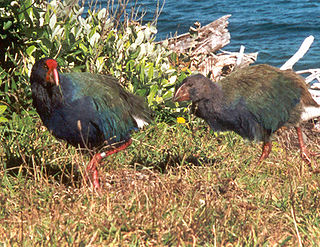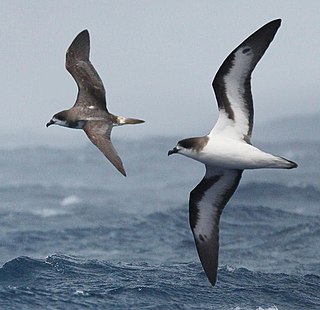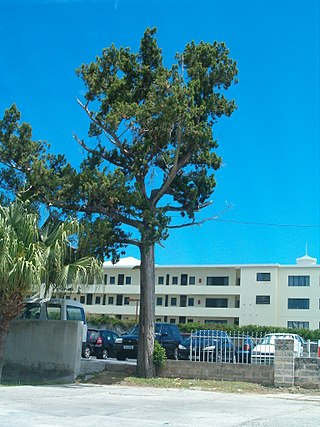
Procellariiformes is an order of seabirds that comprises four families: the albatrosses, the petrels and shearwaters, and two families of storm petrels. Formerly called Tubinares and still called tubenoses in English, procellariiforms are often referred to collectively as the petrels, a term that has been applied to all members of the order, or more commonly all the families except the albatrosses. They are almost exclusively pelagic, and have a cosmopolitan distribution across the world's oceans, with the highest diversity being around New Zealand.

Bermuda is an overseas territory of the United Kingdom in the North Atlantic Ocean. Located off the east coast of the United States, it is situated around 1,770 km (1,100 mi) northeast of Miami, Florida, and 1,350 km (840 mi) south of Halifax, Nova Scotia, west of Portugal, northwest of Brazil, 1,759 km (1,093 mi) north of Havana, Cuba and north-northeast of San Juan, Puerto Rico. The nearest landmass is Cape Hatteras, North Carolina, about 1,030 km (640 mi) west-northwest, followed by Cape Sable Island, Nova Scotia, Canada 1,236 km northward. Although commonly referred to in the singular, the territory consists of approximately 138 islands, with a total area of 57 km2 (22 sq mi).

The gadfly petrels or Pterodroma are a genus of about 35 species of petrels, part of the seabird order Procellariiformes. The gadfly petrels are named for their speedy weaving flight, as if evading gadflies (horseflies). The flight action is also reflected in the name Pterodroma, from Ancient Greek pteron, "wing" and dromos, "runner".

The family Procellariidae is a group of seabirds that comprises the fulmarine petrels, the gadfly petrels, the diving petrels, the prions, and the shearwaters. This family is part of the bird order Procellariiformes, which also includes the albatrosses and the storm petrels.

The Fea's petrel is a small seabird in the gadfly petrel genus, Pterodroma. It was previously considered to be a subspecies of the soft-plumaged petrel, but they are actually not closely related at all. However, P. feae is very closely related to Zino's petrel and Desertas petrel, two other species recently split from P. mollis. The gadfly petrels are named for their speedy weaving flight, as if evading horseflies. The flight action is also reflected in the genus name Pterodroma, from Ancient Greek pteron, "wing" and dromos, " runner". This species is named after the Italian zoologist Leonardo Fea (1852-1903).

Zino's petrel or the freira, is a species of small seabird in the gadfly petrel genus, endemic to the island of Madeira. This long-winged petrel has a grey back and wings, with a dark "W" marking across the wings, and a grey upper tail. The undersides of the wings are blackish apart from a triangle of white at the front edge near the body, and the belly is white with grey flanks. It is very similar in appearance to the slightly larger Fea's petrel, and separating these two Macaronesian species at sea is very challenging. It was formerly considered to be a subspecies of the soft-plumaged petrel, P. mollis, but they are not closely related, and Zino's was raised to the status of a species because of differences in morphology, calls, breeding behaviour and mitochondrial DNA. It is one of Europe's most endangered seabirds, with breeding areas restricted to a few ledges high in the central mountains of Madeira.

The black-capped petrel, also known as the diablotín, is a small seabird native to the West Indies in the genus Pterodroma. It is a long-winged petrel with a grey-brown back and wings, with a white nape and rump. Underparts are mainly white apart from a black cap and some dark underwing markings. It picks food items such as squid from the ocean surface.

In paleontology, a Lazarus taxon is a taxon that disappears for one or more periods from the fossil record, only to appear again later. Likewise in conservation biology and ecology, it can refer to species or populations that were thought to be extinct, and are rediscovered. The term Lazarus taxon was coined by Karl W. Flessa and David Jablonski in 1983 and was then expanded by Jablonski in 1986. Paul Wignall and Michael Benton defined Lazarus taxa as, "At times of biotic crisis many taxa go extinct, but others only temporarily disappeared from the fossil record, often for intervals measured in millions of years, before reappearing unchanged". Earlier work also supports the concept though without using the name Lazarus taxon, like work by Christopher R. C. Paul.

Gough Island, also known historically as Gonçalo Álvares, is a rugged volcanic island in the South Atlantic Ocean. It is a dependency of Tristan da Cunha and part of the British overseas territory of Saint Helena, Ascension and Tristan da Cunha. It is approximately 400 km (250 mi) south-east of the Tristan da Cunha archipelago, 2,400 km (1,500 mi) north-east from South Georgia Island, 2,700 km (1,700 mi) west from Cape Town, and over 3,200 km (2,000 mi) from the nearest point of South America.

The Bermuda petrel is a gadfly petrel. Commonly known in Bermuda as the cahow, a name derived from its eerie cries, this nocturnal ground-nesting seabird is the national bird of Bermuda and can be found pictured on Bermudian currency. The Bermuda petrel is the second rarest seabird on the planet. They have medium-sized body and long wings, a greyish-black crown and collar, dark grey upper-wings and tail, white upper-tail coverts and white under-wings edged with black, and the underparts are completely white.

The flora and fauna of Bermuda form part of a unique ecosystem due to Bermuda's isolation from the mainland of North America. The wide range of endemic species and the islands form a distinct ecoregion, the Bermuda subtropical conifer forests.

The ecological restoration of islands, or island restoration, is the application of the principles of ecological restoration to islands and island groups. Islands, due to their isolation, are home to many of the world's endemic species, as well as important breeding grounds for seabirds and some marine mammals. Their ecosystems are also very vulnerable to human disturbance and particularly to introduced species, due to their small size. Island groups, such as New Zealand and Hawaii, have undergone substantial extinctions and losses of habitat. Since the 1950s several organisations and government agencies around the world have worked to restore islands to their original states; New Zealand has used them to hold natural populations of species that would otherwise be unable to survive in the wild. The principal components of island restoration are the removal of introduced species and the reintroduction of native species.

The short-tailed albatross or Steller's albatross is a large rare seabird from the North Pacific. Although related to the other North Pacific albatrosses, it also exhibits behavioural and morphological links to the albatrosses of the Southern Ocean. It was described by the German naturalist Peter Simon Pallas from skins collected by Georg Wilhelm Steller. Once common, it was brought to the edge of extinction by the trade in feathers, but with protection efforts underway since the 1950s, the species is in the process of recovering with an increasing population trend. Its breeding range, however, remains small. It is divided into two distinct subpopulations, one of which breeds on Tori-shima in the Izu islands south of Japan, and the other primarily on the Senkaku Islands in the East China Sea.

Robert Cushman Murphy was an American ornithologist and Lamont Curator of birds at the American Museum of Natural History. He went on numerous oceanic expeditions and was an expert on marine birds, and wrote several major books on them. He described a species of petrel which is now known as Murphy's petrel. Mount Murphy in Antarctica and Murphy Wall in South Georgia are named after him.

Castle Harbour is a large natural harbour in Bermuda. It is located between the northeastern end of the main island and St. David's Island. Originally called Southampton Port, it was renamed as a result of its heavy fortification in the early decades of the Seventeenth century.

Nonsuch Island is part of the chain of islands which make up Bermuda. It is in St George's Parish, in the northeast of Bermuda. It is 5.7 ha in area and is at the east entrance to Castle Harbour, close to the south-easternmost point of Cooper's Island. Among the island's charted features is a bay called Nonsuch Bay.

The Bonin petrel or nunulu is a seabird in the family Procellariidae. It is a small gadfly petrel that is found in the northwest Pacific Ocean. Its secretive habits, remote breeding colonies and limited range have resulted in few studies and many aspects of the species' biology are poorly known.

The white-bellied storm petrel is a species of seabird in the family Oceanitidae. It is found in Angola, Argentina, Australia, Brazil, Chile, Ecuador, French Polynesia, French Southern Territories, Maldives, Namibia, New Zealand, Perú, Saint Helena, and South Africa. Its natural habitat is open seas.
Louis Leon Arthur Mowbray was a Bermudian naturalist.


















